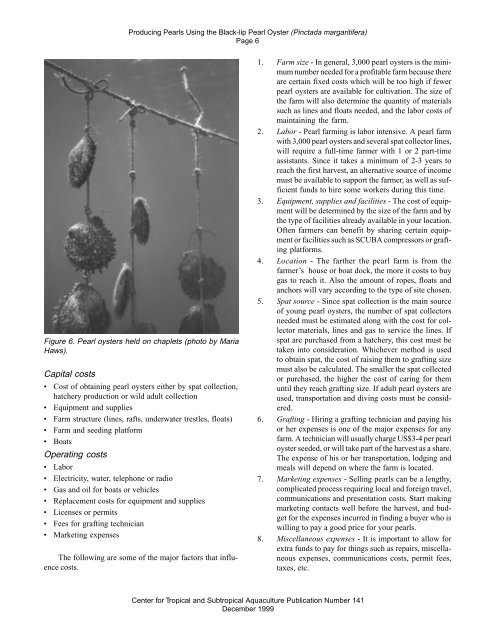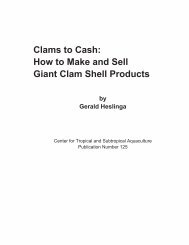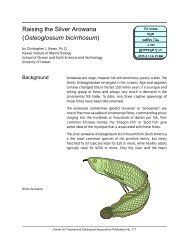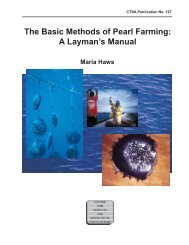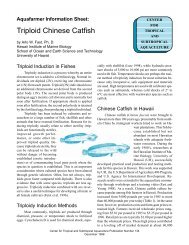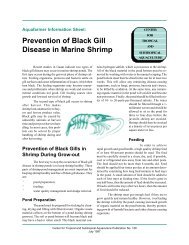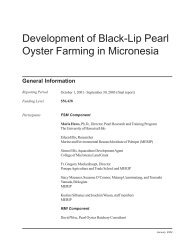Producing Pearls Using the Black-lip Pearl Oyster - CTSA
Producing Pearls Using the Black-lip Pearl Oyster - CTSA
Producing Pearls Using the Black-lip Pearl Oyster - CTSA
Create successful ePaper yourself
Turn your PDF publications into a flip-book with our unique Google optimized e-Paper software.
<strong>Producing</strong> <strong><strong>Pearl</strong>s</strong> <strong>Using</strong> <strong>the</strong> <strong>Black</strong>-<strong>lip</strong> <strong>Pearl</strong> <strong>Oyster</strong> (Pinctada margaritifera)Page 6Figure 6. <strong>Pearl</strong> oysters held on chaplets (photo by MariaHaws).Capital costs• Cost of obtaining pearl oysters ei<strong>the</strong>r by spat collection,hatchery production or wild adult collection• Equipment and supplies• Farm structure (lines, rafts, underwater trestles, floats)• Farm and seeding platform• BoatsOperating costs• Labor• Electricity, water, telephone or radio• Gas and oil for boats or vehicles• Replacement costs for equipment and supplies• Licenses or permits• Fees for grafting technician• Marketing expensesThe following are some of <strong>the</strong> major factors that influencecosts.1. Farm size - In general, 3,000 pearl oysters is <strong>the</strong> minimumnumber needed for a profitable farm because <strong>the</strong>reare certain fixed costs which will be too high if fewerpearl oysters are available for cultivation. The size of<strong>the</strong> farm will also determine <strong>the</strong> quantity of materialssuch as lines and floats needed, and <strong>the</strong> labor costs ofmaintaining <strong>the</strong> farm.2. Labor - <strong>Pearl</strong> farming is labor intensive. A pearl farmwith 3,000 pearl oysters and several spat collector lines,will require a full-time farmer with 1 or 2 part-timeassistants. Since it takes a minimum of 2-3 years toreach <strong>the</strong> first harvest, an alternative source of incomemust be available to support <strong>the</strong> farmer, as well as sufficientfunds to hire some workers during this time.3. Equipment, supplies and facilities - The cost of equipmentwill be determined by <strong>the</strong> size of <strong>the</strong> farm and by<strong>the</strong> type of facilities already available in your location.Often farmers can benefit by sharing certain equipmentor facilities such as SCUBA compressors or graftingplatforms.4. Location - The far<strong>the</strong>r <strong>the</strong> pearl farm is from <strong>the</strong>farmer’s house or boat dock, <strong>the</strong> more it costs to buygas to reach it. Also <strong>the</strong> amount of ropes, floats andanchors will vary according to <strong>the</strong> type of site chosen.5. Spat source - Since spat collection is <strong>the</strong> main sourceof young pearl oysters, <strong>the</strong> number of spat collectorsneeded must be estimated along with <strong>the</strong> cost for collectormaterials, lines and gas to service <strong>the</strong> lines. Ifspat are purchased from a hatchery, this cost must betaken into consideration. Whichever method is usedto obtain spat, <strong>the</strong> cost of raising <strong>the</strong>m to grafting sizemust also be calculated. The smaller <strong>the</strong> spat collectedor purchased, <strong>the</strong> higher <strong>the</strong> cost of caring for <strong>the</strong>muntil <strong>the</strong>y reach grafting size. If adult pearl oysters areused, transportation and diving costs must be considered.6. Grafting - Hiring a grafting technician and paying hisor her expenses is one of <strong>the</strong> major expenses for anyfarm. A technician will usually charge US$3-4 per pearloyster seeded, or will take part of <strong>the</strong> harvest as a share.The expense of his or her transportation, lodging andmeals will depend on where <strong>the</strong> farm is located.7. Marketing expenses - Selling pearls can be a lengthy,complicated process requiring local and foreign travel,communications and presentation costs. Start makingmarketing contacts well before <strong>the</strong> harvest, and budgetfor <strong>the</strong> expenses incurred in finding a buyer who iswilling to pay a good price for your pearls.8. Miscellaneous expenses - It is important to allow forextra funds to pay for things such as repairs, miscellaneousexpenses, communications costs, permit fees,taxes, etc.Center for Tropical and Subtropical Aquaculture Publication Number 141December 1999


